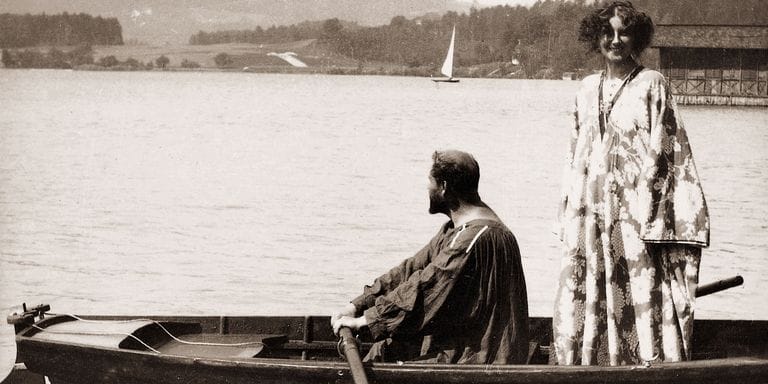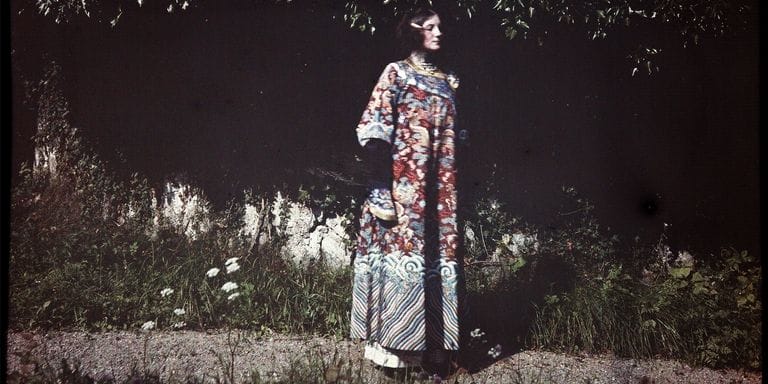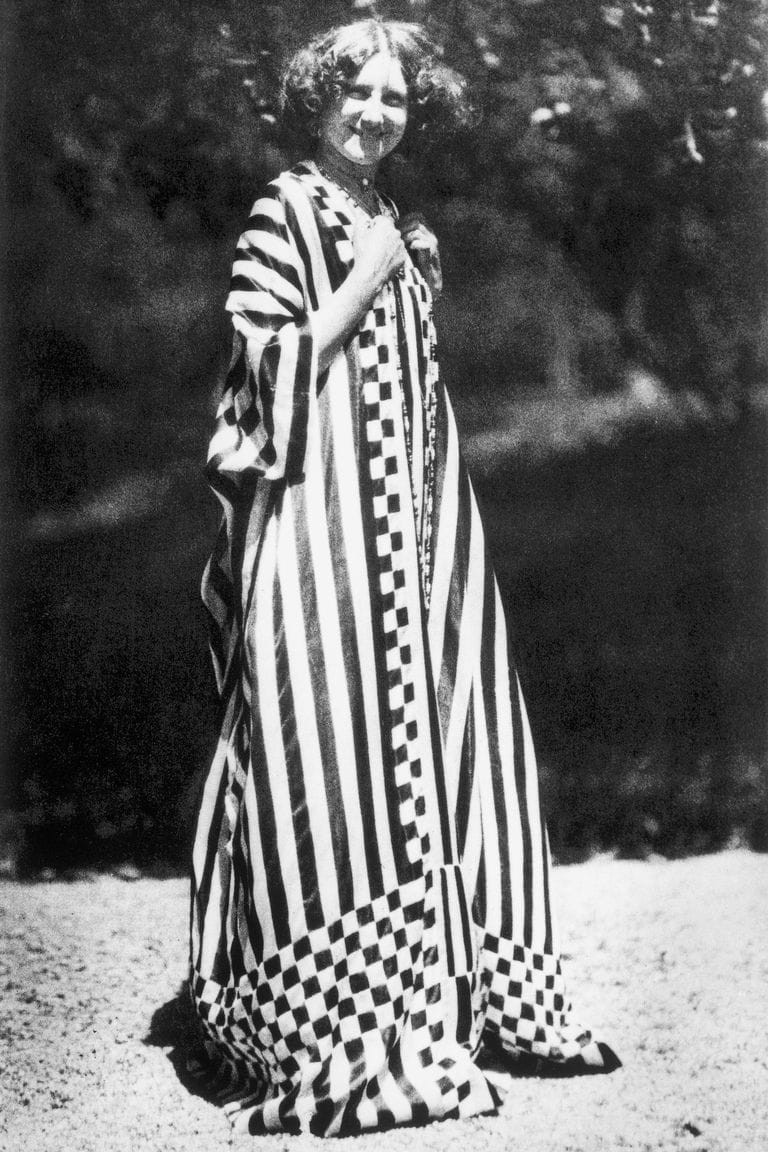
Getty
In Gustav Klimt’s iconic painting The Kiss, a couple embraces and their gold leaf-flecked robes swirl together in scintillating patterns. Many believe that the couple represent Klimt and the fashion designer Emilie Flöge, whose decades-long romance generated bold, envelope-pushing creative collaborations. But while Klimt’s highly controversial portraits scandalized collectors and propelled him into the spotlight, Flöge, a successful businesswoman and fearless, trailblazing designer, remains a hidden gem—largely unknown and unrecognized in the fashion history.
Coco Chanel is often heralded as the sole designer to revolutionize modern womenswear, and it’s true that she popularized trousers and comfortable two-piece suits at a time when upper-class women had limited sartorial options. But by the time Chanel opened her salon at 31 Rue Cambon in Paris in 1910, Flöge had been producing cutting-edge designs in Vienna for several years, already carving out new roles for women in the industry with her empire-waist garments, wide sleeves and intricately-detailed panels inspired by Hungarian and Slavic embroidery, marking a departure from the restrictive, corseted dresses that were the mainstays for the time.

Emilie Flöge pictured in 1909
Getty
In 1904, Emilie and her two sisters opened the fashion house Schwestern Flöge on Vienna’s bustling Mariahilfer street—an unusual venture for three unmarried, thirty-something women to take on then. (Klimt and Flöge’s relationship was also extremely unusual: they were romantic partners that never got married nor had children, and maintained a level of independence unprecedented for the time.)
Flöge flourished at a time when the retail industry in Vienna was extremely polarized: as department stores made ready-to-wear clothes available to the masses, skilled tailors served an increasingly limited but formidable pool of upper-class women. At its prime, the company employed nearly 80 workers, whom were paid fair wages in accordance with a progressive association of fashion houses that issued minimum wage requirements. In addition to heading the business, Emilie also maintained a direct, hands-on role in production, often pinning fabric to a dummy (custom-made to a client’s proportions) before directing fabric-cutters to reassemble it. Between postcards she exchanged with Klimt and an assistant’s detail-oriented notes, we know that she traveled to Paris twice a year to source fabric, belts and buttons.
Her playful approach to retail design set a precedent for contemporary concept stores like Colette, 10 Corso Como, and Dover Street Market.
Avoiding constraining bodices, and instead favoring easy to wear, smock-like cuts that hung loosely like a modern caftan, Flöge’s signature, playful silhouette reflected the Reform Dress movement that gathered steam across Western Europe at the turn of the century. (Flöge’s voluminous dresses were likely influenced by French couturier Paul Poiret, who did away with the corset in 1906—more-so for aesthetic reasons than necessarily to liberate women.)
Unlike other retail stores, the Flöge sisters displayed alluring art objects that were not for sale, including lapis-lazuli inlaid boxes, tortoise shell combs, marbled paper notebooks, silver chalices and hand-carved wooden dolls. The store was furnished with sleek, adjustable mirrors; geometric, carved wood chairs; and black-and-white chequered tables. Designed by Josef Hoffmann, who also designed Klimt’s studio, the interior was welcoming yet simple and restrained. Instead of copying popular design trends of the time like fishbone tiles or parquet wood floors, Schwestern Flöge was lined with subtle carpet and sold dresses, evening gowns, jackets and suits to Europe’s elite.

Emilie in Chinese dress at the Atter Lake in 1910
Getty
Her art-oriented aesthetic and playful approach to retail design set a precedent for contemporary concept stores like Colette in Paris, 10 Corso Como in Milan, and Dover Street Market in London. The salon’s 30-years in business is a testament to Flöge’s business smarts, as she drew on a wide client base and catered to an international audience that included many American women. The store’s elaborate logo—an Art Nouveau-style text with a checkered border motif—was printed on invoices and labels and turned Schwestern Flöge into an easily recognizable brand.
Klimt sometimes worked in collaboration with Flöge, designing bespoke garments that she modified and then sewed in the Schwestern Flöge’s workshop rooms. In 1907, an experimental Arts and Crafts publication based in Germany commissioned Klimt to take photos of his fashion designs. Because they worked so collaboratively, it’s difficult to discern whether Flöge or Klimt designed the garments in the photos. Klimt is captured wearing a bag-like robe that is incongruous with his painting style — which was elaborate and lavishly patterned. This unadorned and frank, spartan look was meant to demonstrate his rejection of traditional Bourgeois values.

Emilie in the garden of Klimt’s studio in 1905
Getty
In Klimt’s paintings, women are seen as both muses and self-possessed subjects, and as erotically charged while in control of their sexual expression. In Portrait of Emilie Flöge, Klimt depicts Flöge as an elegant woman swathed in a dazzling, floor-grazing dress of her own design. The painting’s three-quarters view is conventional, but her dress is cut in a rebellious style. (Flöge’s mother Barbara disapproved of the portrait, and was upset that Klimt went on to sell it to a client.)
When the Museum of Modern Art (MoMA) planned the exhibit “Vienna 1900: Art, Architecture and Design” in 1986, Flöge’s work—designing, sewing and producing garments—with Klimt is sharply overlooked, treated as a peripheral component of Klimt’s legacy. Of course, Klimt was a seminal figure in fin de siècle Vienna: he popularized an ornamental style of painting and served as president of The Secession, a group of artists that rebelled against the Royal Academy’s stodgy traditions. But while he was celebrated as “a culture hero whose stature transcended matters of medium or style,” Flöge’s contributions were seen as more niche, which pigeonholed her to a specific epoch of Austrian history.
By the time Nazis invaded Austria in 1938, many of Schwestern Flöge’s clientele, who were Jewish, had fled the country or were deported to concentration camps. Like neighboring businesses — both established and burgeoning — they were forced to close. Though Flöge’s inventive business practices and avant-garde designs have been kept a secret and remain a buried treasure in Viennese history, her design aesthetic lives on in free-flowing dress silhouettes and a revived popular interest in embroidery.
From: Harper’s BAZAAR US



